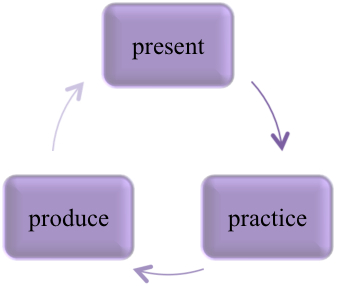
A teacher may select a topic such as cooking and eating. In this topic the students will learn to use languages for the purposes of identifying and naming, asking for food, asking about food, offering food and sharing it, telling someone what to do when preparing the food, responding to (spoken and/or written) instructions when preparing food.In this example, the teacher has moved from introducing single words to introducing language structures. Together, these enable the students to communicate with each other in the target language.
They will learn nouns such as names of food, e.g. flour, oil, meat, vegetable food. Other nouns will include things needed to prepare and cook the food, e.g. knife, pot, fire, water. Adjectives will be helpful to describe the nouns, e.g. hot, cold, big, small, long, red, black, white. The students will use verbs needed for cooking and eating situations, e.g. cut, make, heat, mix. They could also use pronouns to explain who will be doing the actions, e.g. you (one person), you (two people), you (all of you), us two, all of us.
All of the vocabulary items (nouns, adjectives, verbs and pronouns) will fit into language structures, e.g. Whatís this? Itís a ____ . What are these? They are ______ . Pass me the _____ . Pass me the big ______ . Wash this. Wash these. Wash the potatoes. What are you doing? Iím washing the potatoes. Cut the meat. What are you doing? Iím cutting the meat. Heat the water. What am I doing? Iím heating the water. Boil the vegetable food. Stir it. Fry the _____ . Turn it over now. What are you two doing? What is he/she doing? What do we two do next? Whatís that group doing? Is it hot? Is it cold? Is it tasty? Is it ready? Iíll give you some. Eat up! Tastes good? Yes!

Whatís your name?First, the students hear the three questions and answers, in the present step of the cycle. This model is then used by the students to practise. They do this by responding to the teacher asking students around the room one by one. At this stage the students mimic; the whole class might speak in unison, copying and repeating after the teacher. In the next activity the students are more independent Ė they produce what theyíve learned, by rehearsing with a partner and/or by walking around the room and talking with several classmates one by one. For this activity, the teacher might give them a short handout to complete:
Iím ____________ .
Where are you from?
Iím from _________ .
Where do you live?
I sit down / live in _________ .
Whatís your language?
I speak / learn _________ .
Using the questions you have just learned, interview 6 classmates and ask them for their name, where they are from, where they live and which language they speak/learn.
Name From Lives Language 1
2
3
4
5
6
Providing information
about good teaching for reviving Australian languages is one of
the main purposes of this website. To make it more accessible we
have arranged it under the following headings: